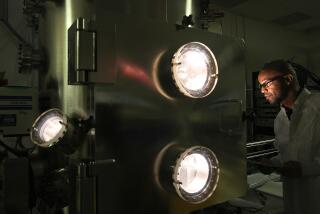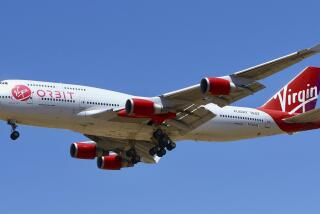AeroVironment shares soar after investor buys 5.1% stake
- Share via
AeroVironment Inc., hurt by a drop in military contracts for its tiny drones, got a shot in the arm from a new investment company that wants to wean it from the government trough and move its products more into the commercial market.
Engaged Capital, an upstart Newport Beach activist investment firm founded in September, said it has spent $23 million to acquire a 5.1% stake in the Monrovia company.
The new shareholder is “fully committed” to working with AeroVironment’s board and management to help improve the company’s value, said Glenn W. Welling, Engaged Capital’s chief investment officer.
He said AeroVironment needs to invest its excess cash, form a more specific growth plan and reduce its reliance on government contracts, which until recently have accounted for about 80% of sales.
Engaged Capital said it saw a company that was drastically undervalued and, since November, has acquired shares, according to a July 11 filing with the U.S. Securities and Exchange Commission. News of its holdings Wednesday sent AeroVironment stock up $2.92, or 14.1%, to $23.57.
The disclosure came less than a month after AeroVironment reported that a drop in demand from the military, which has been winding down its presence in the Middle East, caused the company’s revenue to sink by half to $54.1 million during its fiscal fourth quarter, which ended April 30.
AeroVironment has been the Pentagon’s top supplier of small drones — including the Raven, Wasp and Puma models — that give troops on the ground a bird’s-eye view of what’s happening over a ridge or around a bend.
Military contracts fueled the growth of the once-tiny company into a publicly traded defense contractor by 2007 with thousands of drones at work in the war zone.
With the U.S. preparing to pull troops out, though, the company has to find sales elsewhere.
It hopes, for instance, that it can sell its small spy drones made in Simi Valley to a wider customer base in the coming years with the Federal Aviation Administration’s impending introduction of regulations that would allow small drones into U.S. airspace in 2015.
It also makes other products, such as residential charging stations for the Nissan Leaf, and it continues to expand internationally.
Until Wednesday, AeroVironment stock had traded in a range of $17.98 to $20.65.
“It seems there’s been investor fatigue that has set in on the stock price,” said Peter Arment, aerospace analyst with Sterne Agee Group Inc. “This investor group wants to close the discount that’s set in AeroVironment’s stock price with what they believe is the true valuation.”
Engaged Capital is known as an activist firm that makes concentrated investments in what it sees as undervalued public companies and then pushes for strategic change and increased shareholder value.
“An activist shareholder wants to influence a board or management to do something,” said Brian Ruttenbur, an analyst with financial services firm CRT Capital Group. “Whatever it is, they have a mission to get better returns for shareholders, that they’re now one of.”
AeroVironment said in a statement that it “maintains and welcomes open communications with all of its stockholders and values their input toward the goal of enhancing stockholder value. We will continue to take actions that we believe enable us to achieve this objective.”
AeroVironment was founded by the late aviation pioneer Paul B. MacCready. Its aviation ambitions began with attempts to win a much-needed $100,000 prize for the first human-powered airplane. It won the prize with the Gossamer Condor, which hangs at the National Air and Space Museum in Washington.
MacCready then built the Gossamer Albatross, which crossed the English Channel on pedal power.
All the while, quietly in the company’s back rooms, engineers also were dabbling in a new frontier in aviation — making planes ever smaller and closer in design to small birds. That research paid off after the Sept. 11, 2001, terrorist attacks that sent the Pentagon looking for ways to protect U.S. troops from elusive insurgents.
When special forces units were dispatched in 2001 to the desolate outcroppings of Afghanistan to stalk and eradicate the Taliban, the commandos were outfitted with radios, night-vision goggles and automatic rifles.
But they also carried a tiny robotic spy plane, so small it would fit in a backpack.
The technology enabled them to avoid ambushes and pinpoint the location of enemy positions.
AeroVironment went on to develop an array of small drones that quickly became a staple of U.S. military operations. Its technology fueled the growth of the once-tiny company into a publicly traded defense contractor by 2007 with thousands of drones at work in the war zone.
As it looks for new markets now, AeroVironment said it still plans to “maintain our market leadership in unmanned aircraft systems and electric transportation solutions.”
Twitter: @wjhenn
Times staff writer Cale Ottens contributed to this report.
More to Read
Inside the business of entertainment
The Wide Shot brings you news, analysis and insights on everything from streaming wars to production — and what it all means for the future.
You may occasionally receive promotional content from the Los Angeles Times.











